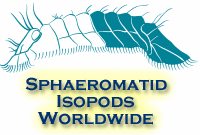| Abstract |
The nuclear ssu rRNA gene of several isopods (Crustacea, Peracarida) was sequenced to study its phylogenetic information content. Several areas had to be cut out of the alignment of 31 isopod sequences and selected outgroup arthropod sequences due to the lack of alignable patterns. The final alignment had 2,533 positions and 43 sequences. The length of the isopod nuclear ssu rRNA genes varies between 2,098 and 3,402 bp. In some clades the gene length increases in others like the cymothoids and bopyrids, long deletions occur. Some insertions are specific for major groups (e.g.. amphipods, isopods). Most elongation areas evolve rapidly and are not alignable among higher taxa. Information content is visualized with spectra of supporting positions, Only a few groups are unambiguously supported with a signal distinctly higher than background noise. The results of maximum parsimony analyses are congruent with major aspects of earlier hypotheses on isopod phylogeny. Some contradictions are discussed. The latter are mainly based on a lack of reliable information A major monophyletic group found in the molecular phylogenies and also supported by distinct morphological characters is named Scutocoxifera tax. nov., composed of the Oniscidea, Valvifera, Sphaeromatidea, Anthuridea, and Cymothoida. SEM photographs are presented to document the apomorphic state of the coxa in the Scutocoxifera. |

















